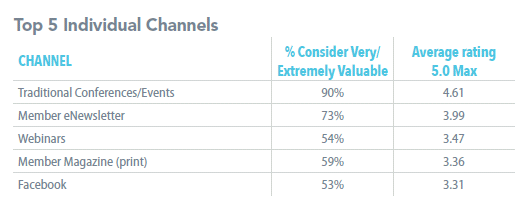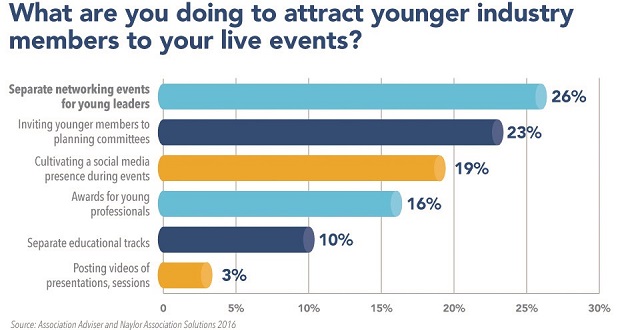Solutions for Your Membership Conundrum
Delivering the right value to the right members at the right time.

Members tell us we’re sending them too much. The same members tell us they never know about events, professional development opportunities or other benefits to which they’re entitled. If this sounds like your organization, you’re not alone. For the fifth consecutive year, the majority of association leaders (68 percent) cited “Inability to Communicate Member Benefits Effectively” as their second most significant member communication challenge, trailing only information overload (69 percent). These findings from Naylor’s annual association communication benchmarking study also revealed that “Difficulty Engaging Young Professionals” (56 percent) is now the third most frequently cited challenge, up from No. 4 in 2015.
Rather than folding up the tent on the membership association model, however, many high-performing organizations are rethinking their brands and their business models. And guess what? Some longstanding tactics and communication channels remain part of the future.
![]()
There’s a disconnect between why young members join and why associations THINK they join. ![]()
Renewal numbers will increase if you provide valuable training and professional development that members can’t easily find elsewhere. ![]()
Mentoring programs benefit members at all career stages. But programs must be diligently managed. ![]()
The value of face-to-face interaction
Carl Good, vice president of membership, marketing and business development at the National Roofing Contractors Association (NRCA), said face-to-face interaction with an association is still highly valuable for members. “In our industry our members are going from 5 a.m. until late at night during their busy season. They miss a lot of things that we send them through the mail or electronically and they don’t have time to visit our website unless they’re looking for something specific. And when we get them face to face, they get to ask questions we can’t filter through when we send them other types of communications.

Source: Association Adviser and Naylor Association Solutions 2016
Trade shows not a dying breed
Early results of our unscientific reader poll show that one in four associations (26 percent) are now offering separate networking events for young leaders at their live events. While that may not surprise you, did you know that 23 percent of associations tell us they are inviting younger members to join their event planning committees? These tactics eclipsed the number of associations that are cultivating a social media presence during their live events (19 percent), offering awards for young professionals (16 percent) or offering separate educational tracks for young professionals (10 percent).

“We don’t very often give millennials the mic and ask them directly, ‘what’s important to you in life?’” observed Patrick Leclerc, president & CEO of the Canadian Urban Transit Association, which has a number of tracks and events for young transit professionals at its conferences. “We don’t ask them often enough: ’What do you expect in the workplace? How do you move around your community and what do want your community to look like?’ That’s what attendees and policy makers need to hear.”
NCRA’s Good recalled a time 10 years ago when his leadership team thought trade shows were a dying breed. Instead, NCRA has found the opposite to be true. “There’s just something you get from having that interaction with somebody else who’s in your industry and can talk the same language that you talk. That is what [members] tell us is one of the most important benefits.”
A helping hand for newer (most at risk) members most at risk
New data from Edge Research, commissioned by Abila, Inc., showed a significant disconnect between the reasons young people join associations and the reasons associations THINK young people join. At a recent webinar deconstructing the findings, Jamie Notter, founding partner at WorkXO, LLC said many membership organizations are still stuck in the model of: “Pay to join us first and then we’ll show you our valuables.” Notter said that’s a hard sell for always-connected young professionals who are “used to getting value instantaneously.”
They’re used to the “freemium model,” Notter said, and then they upgrade to the paid model if they like it.
Top 3 reasons young people join associations
| Job opportunities | 34% |
| Socializing | 30% |
| Certifications | 24% |
Source: Abila, Inc., Edge Research 2016
Top 3 reasons associations THINK they join
| Conferences | 48% |
| Networking | 45% |
| Advocacy | 38% |
Source: Abila, Inc., Edge Research 2016
NRCA’s Carl Good said NRCA noticed that the majority of members who didn’t renew were those who belonged for less than two years. In response, NRCA hired a membership experience coordinator who calls new members after they join, gets them registered for NRCA’s website and electronic newsletters and generally stays in regular contact with them every three months during the critical first year of membership. “It’s not just a welcome call. It’s to remind them: ‘Hey, we’re here for you. We have a lot of benefits you may be interested in,’” he says, including technical details they can put into proposals and other benefits they wouldn’t immediately recognize.
Randy Fiser, CEO of the American Society of Interior Designers, said that before a live event, ASID gives young members a guided tour of the trade show so they can “experience from a seasoned professional what they should be looking for in their conversations with vendors who are showcasing their work.”
Re-thinking your brand
After 60 years as the Midwest Society of Association Executives, the Society recently rebranded itself as Associations North to better reflect its “dedication and commitment to Moving Professionals Forward” explained by the organization’s 2016-17 chair, Ann Kvaal.
According to Association North’s marketing and communications manager, Angela Kisskeys, “we want a brand that is relevant, meaningful and easy to understand. The simplicity and brevity in the name is necessary to remaining relevant in the marketplace.”
For more about Association North’s rebranding effort, read our interview with Kisskeys: Luggage Tags and Breath Mints.
Tactics for engaging millennials
Re-branding isn’t the only way to connect with millennials. Association Adviser’s annual benchmarking study found that inviting young members to participate on volunteer committees (54 percent), gearing events toward young professional education and development (53 percent) and creating communications targeted to younger members (41 percent) are now the most frequently used tactics for connecting with up-and-coming members of their industry profession, more so than mobile and social initiatives.
You also have to sound genuine, according to Russ Webb, vice president of the Atlanta Apartment Association (AAA). “Our communications coordinator is only one year out of college. Everything we plan to send out to members and the public must go through her. If she thinks any communication piece is not going to resonate with younger members, she’s quick to let us know.”
See our 2016 Corner Office roundtable for more about connecting with millennials.
Meanwhile, my colleague Holly Marsilio has more in today’s issue about using big data to keep members engaged and motivated.
Helping members with their biggest challenges
David Lewis, executive director of the Arizona Association of School Business Officials, said his organization encourages members to contact AASBO any time they have a question about a business, administrative or staff training issue. In addition to being a trusted answer source for members, Lauren Hoffmann, director of marketing, communications and membership for the Mid-Atlantic section of the United States Tennis Association said associations can also elevate the member experience by serving as a valued researcher and content curator for them and by helping them mine discussion forums to find fellow members with success stories to share..
Chip Rogers, president & CEO of the Asian American Hotel Owners Association, said AAHOA holds 10 to 12 events for young professional hoteliers across the country who want to advance their professional learning beyond what they can learn from predominantly family-run businesses—“learning how to develop the Hyatt brand and leveling the playing field” against unconventional competitors like Airbnb.
Associations uniquely positioned to close skills gaps
Many high performing associations are finding that they can earn substantial increase their renewal numbers by providing members with training, workshops, webinars and certifications that they would have trouble finding elsewhere.
“If someone is doing one particular job and they move on to another area, the school district doesn’t automatically hire someone else to do that job. They just assign those tasks to somebody else who’s already at the school district who must get trained in those areas as well,” AASBA’s Lewis noted. Making sure that the right training and workshops are readily available for the right members at the right time has been a big focus for AASBO, Lewis added.
Brenda Orffer, director of member services for the Washington Health Care Association, said her WHCA is dedicated to “bringing education to the members rather than bringing members to the education.” After successfully introducing webinars five years ago, WHCA more recently started on-site personalized education programs for members, which allows them to learn new techniques on equipment they’re familiar with and not leave their facilities short-staffed like they would if they traveled off-site for training.
The many benefits of mentoring programs
A California Nurse Mentor Project study found that mentoring reduced RN attrition, saving hospitals between $1.4 million and $5.8 million over three years. Specific benefits to the organization include: reduced turnover and recruiting costs, assistance in knowledge transfer from retiring workers to new workers and help for employees to gain skills and knowledge.
“There’s nothing more gratifying than teaching and mentoring people,” Betsy Monseu, CEO of the American Coal Council (ACC) told us recently. “It’s important for those in management to facilitate relationships and allow people to grow. But, it’s also important for those being mentored to make the relationship mutually beneficial.”
AGC Georgia’s Dunham agreed. “I was blessed to have many veteran members willing to guide me and advise me,” he said. “I could call them any time up to ask a question. I also spent a lot of time riding around in their pickup trucks listening to their war stories. All of a sudden I’m one of those guys with 35 years of experience who’s mentoring the younger folks,” he chuckled.
Conclusion
From old school F2F to real-time apps, associations keep finding ways to defy the naysayers and engage with members of all ages who share a common occupational interest and desire to do what’s best for their industry and careers.
Hank Berkowitz is the moderator-in-chief of Association Adviser eNews.

